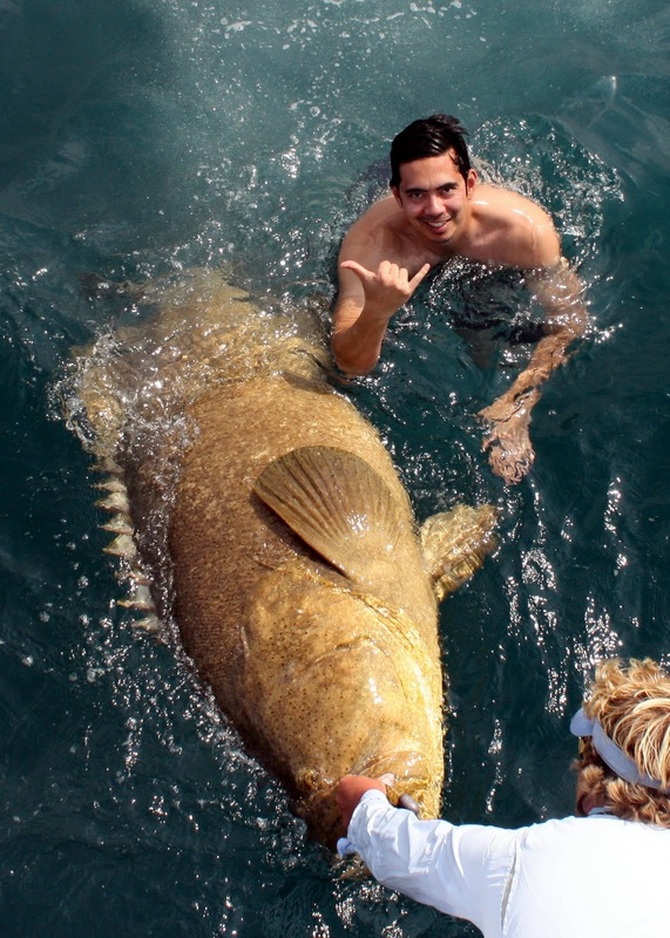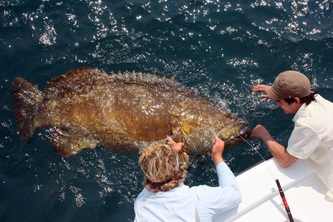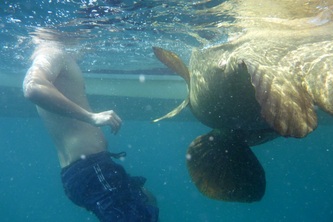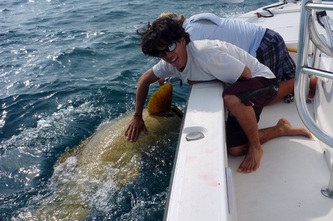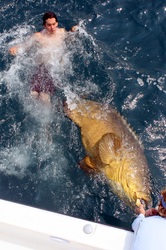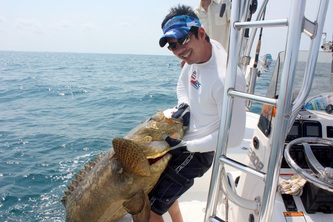Goliath Grouper
Epinephelus itajara
Home
Other Species
Goliath Grouper Description
Goliath Grouper, as the name suggests, are a very large species of Grouper. They are so large that they require specialized techniques and therefore get their own section on this site. Goliaths can achieve weights of over 800lbs although specimens that large are almost impossible to catch. These behemoths do not have a lot of stamina and fights are often fairly brief on the super heavy tackle they require, but the first power run they take to the bottom will strain the arms of even the strongest anglers. If you can fish these guys with 90lbs of drag in standup gear without a chair or harness you should probably call ESPN about the World’s Strongest Man contest.
The largest Goliath Grouper I hooked broke the boat off the anchor, towed us around, and snapped an impossibly thick rod. We didn't have another rod that heavy so we had to resort to handlining after that. They will engulf almost any reef fish you hook in certain parts of Florida, including Snappers, Permit, rays, sharks, etc. In some parts of Florida their primary food source is stealing fish that have been hooked by fishermen.
Goliaths are protected in the United States and must be released. Good luck finding many of them in places they aren't protected. They are too easy to target for spearfishermen.
Want to get a sense for what it's like to fish for these monsters? Check out this short video clip: http://www.youtube.com/watch?v=H59lpEXPDSI
Goliath Grouper Pound for Pound Fight Rating - 9.5 out of 10 on the Saltwater Scale
Goliath Groupers, like most groupers, head straight into their rocky homes when hooked. They have a lot more bulk than most groupers, and only the stoutest of tackle will keep them from reaching freedom. Strictly speaking they are probably not near the top of the list pound for pound, but they usually have so many pounds behind them that I bumped them up several points. Some of the really big ones are essentially impossible to land on rod and reel, because no matter how strong your line is and how tight your drag is, they will just pull the boat backwards and break you off in the rocks. Even the strongest rods will eventually get broken fishing for Goliaths. If you survive the initial run and turn them they usually tire fast and come to the boat. However, I don't know of any other fish that is harder to keep from the rocks.
Goliath Grouper Culinary Rating - High
They are slow growing and not super numerous, so I generally release them. Also, it is illegal to keep them in many places. However, they were hunted to near extinction for their meat so I assume they taste good.
Goliath Grouper Tackle
This is one of the most specialized fisheries there is in terms of tackle. You need a large reel capable of 90lbs of drag and loaded with 400lb+ monofilament if you want to consistently land the big ones. You can land some with lesser tackle but you will break a lot off and that is not good for you or the fish. Luckily you don’t need a lot of line because you either win or lose the battle with the first 25 or so yards of line. This is one of the few fish where monofilament is preferable to braid because the stretch is the only “drag” you use. Whatever rod you use will eventually snap after a few large fish with that amount of drag. I highly recommend you find one of the few guides who really specializes in this type of fishing and use their gear. That being said, I was able to land a 175lber on heavy spinning gear (100lb braid on a Daiwa Saltiga Dogfight reel) when we were fortunate enough to hook it far from a reef. It's always better to be lucky than good.
Smaller Goliaths hang around docks and pilings and can be landed on lighter tackle. However, I still recommend a minimum of 100lb test. Too many fish get hooked on overly light gear and then have to swim around with hooks in their mouths.
Large circle hooks are the way to go to avoid gut hooking and facilitate release.
Goliath Grouper Techniques
Large Goliath Grouper are almost exclusively caught on live or dead bait. The key to successful Goliath Grouper fishing is anchoring close enough to the reef or wreck so that they will come out to eat your bait, but far enough away that you have a chance of pulling them away before they get back and break you off. One tip to help them find the bait is to bounce it off the bottom to create some commotion. These fish have no predators and are not shy.
Goliath Grouper Lures
No lures that I know of are consistently effective on large Goliath Grouper. I did catch one around 55lbs on a leadhead jig with a feather tail in the Florida Keys.
Goliath Grouper Baits
Various types of rays caught in the area you are fishing work well. They give off a lot of scent and work even when dead. Any type of 1-15lb live fish should work well but many are illegal to use for bait in Florida.
Where to get the big Goliath Grouper
The only place I know of to really pursue these guys is South Florida. Because of the ban on keeping them their numbers have increased significantly, and this is one of the few places you can find a guide who specializes in them. If you have the tackle it would not be too difficult to target them on your own as they are not shy. In most of the rest of their range that I know of they are pretty fished out and not available in sufficient numbers to target successfully.
Other Goliath Grouper Resources
The above barely scratches the surface on how to catch Goliath Groupers. The guide service below will put you on fish. They know more about catching Goliaths than anyone I have heard about:
www.anotherkeeper.com
Epinephelus itajara
Home
Other Species
Goliath Grouper Description
Goliath Grouper, as the name suggests, are a very large species of Grouper. They are so large that they require specialized techniques and therefore get their own section on this site. Goliaths can achieve weights of over 800lbs although specimens that large are almost impossible to catch. These behemoths do not have a lot of stamina and fights are often fairly brief on the super heavy tackle they require, but the first power run they take to the bottom will strain the arms of even the strongest anglers. If you can fish these guys with 90lbs of drag in standup gear without a chair or harness you should probably call ESPN about the World’s Strongest Man contest.
The largest Goliath Grouper I hooked broke the boat off the anchor, towed us around, and snapped an impossibly thick rod. We didn't have another rod that heavy so we had to resort to handlining after that. They will engulf almost any reef fish you hook in certain parts of Florida, including Snappers, Permit, rays, sharks, etc. In some parts of Florida their primary food source is stealing fish that have been hooked by fishermen.
Goliaths are protected in the United States and must be released. Good luck finding many of them in places they aren't protected. They are too easy to target for spearfishermen.
Want to get a sense for what it's like to fish for these monsters? Check out this short video clip: http://www.youtube.com/watch?v=H59lpEXPDSI
Goliath Grouper Pound for Pound Fight Rating - 9.5 out of 10 on the Saltwater Scale
Goliath Groupers, like most groupers, head straight into their rocky homes when hooked. They have a lot more bulk than most groupers, and only the stoutest of tackle will keep them from reaching freedom. Strictly speaking they are probably not near the top of the list pound for pound, but they usually have so many pounds behind them that I bumped them up several points. Some of the really big ones are essentially impossible to land on rod and reel, because no matter how strong your line is and how tight your drag is, they will just pull the boat backwards and break you off in the rocks. Even the strongest rods will eventually get broken fishing for Goliaths. If you survive the initial run and turn them they usually tire fast and come to the boat. However, I don't know of any other fish that is harder to keep from the rocks.
Goliath Grouper Culinary Rating - High
They are slow growing and not super numerous, so I generally release them. Also, it is illegal to keep them in many places. However, they were hunted to near extinction for their meat so I assume they taste good.
Goliath Grouper Tackle
This is one of the most specialized fisheries there is in terms of tackle. You need a large reel capable of 90lbs of drag and loaded with 400lb+ monofilament if you want to consistently land the big ones. You can land some with lesser tackle but you will break a lot off and that is not good for you or the fish. Luckily you don’t need a lot of line because you either win or lose the battle with the first 25 or so yards of line. This is one of the few fish where monofilament is preferable to braid because the stretch is the only “drag” you use. Whatever rod you use will eventually snap after a few large fish with that amount of drag. I highly recommend you find one of the few guides who really specializes in this type of fishing and use their gear. That being said, I was able to land a 175lber on heavy spinning gear (100lb braid on a Daiwa Saltiga Dogfight reel) when we were fortunate enough to hook it far from a reef. It's always better to be lucky than good.
Smaller Goliaths hang around docks and pilings and can be landed on lighter tackle. However, I still recommend a minimum of 100lb test. Too many fish get hooked on overly light gear and then have to swim around with hooks in their mouths.
Large circle hooks are the way to go to avoid gut hooking and facilitate release.
Goliath Grouper Techniques
Large Goliath Grouper are almost exclusively caught on live or dead bait. The key to successful Goliath Grouper fishing is anchoring close enough to the reef or wreck so that they will come out to eat your bait, but far enough away that you have a chance of pulling them away before they get back and break you off. One tip to help them find the bait is to bounce it off the bottom to create some commotion. These fish have no predators and are not shy.
Goliath Grouper Lures
No lures that I know of are consistently effective on large Goliath Grouper. I did catch one around 55lbs on a leadhead jig with a feather tail in the Florida Keys.
Goliath Grouper Baits
Various types of rays caught in the area you are fishing work well. They give off a lot of scent and work even when dead. Any type of 1-15lb live fish should work well but many are illegal to use for bait in Florida.
Where to get the big Goliath Grouper
The only place I know of to really pursue these guys is South Florida. Because of the ban on keeping them their numbers have increased significantly, and this is one of the few places you can find a guide who specializes in them. If you have the tackle it would not be too difficult to target them on your own as they are not shy. In most of the rest of their range that I know of they are pretty fished out and not available in sufficient numbers to target successfully.
Other Goliath Grouper Resources
The above barely scratches the surface on how to catch Goliath Groupers. The guide service below will put you on fish. They know more about catching Goliaths than anyone I have heard about:
www.anotherkeeper.com
